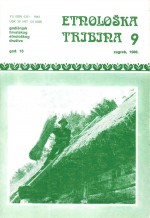Jezični odnosi u karlovačkom Pokuplju i Beloj krajini
Language Relations in Karlovačko Pokuplje and Bela Krajina
Author(s): Mijo LončarićSubject(s): Geography, Regional studies, Sociolinguistics, Cultural Anthropology / Ethnology
Published by: Hrvatsko etnološko društvo
Keywords: Karlovačko Pokuplje; Bela Krajina; Slovenian and Serbo-Croatian language; standardization of language; isoglosses;
Summary/Abstract: In geographic terms Bela Krajina and Karlovačko Pokuplje make a whole — divided by the Kupa in three parts — which mountains separate from other Slovenian regions. Two languages meet here: Slovene and Serbo-Croatian, as well as three dialects of Serbo-Croatian: čakavian, kajkavian and štokavian. Ancient language situation was altered by Turkish invasions. Yet, on the basis of the present language outlook and written documents, relevant hypotheses can be developed regarding pre-migratory language distribution. The area along the Kupa was most probably kajkavian, while in Bela Krajina kajkavian dialect shaded into Slovene language in such manner that early development of Slovene could have happened only among northwestern speeches, spoken on the slopes of mountains which encircle Bela Krajina. During Turkish invasions, the region by the arch of the Kupa and neighboring banks in Bela Krajina were most damaged. When the warfare quieted down, deserted lands were colonized on one side by the population coming from east and south, particularly from regions where new-Stokavian ijekavian dialect is spoken today; and on the other side, by the population coming from the west, i. e. Dolenjska, to Bela Krajina. The interaction of ancient speeches — where they remained — and different speeches of the new settlers created new types of speeches. In local forms of speech, prevalent elements were those of the dominant speakers. Since this geographic area is small, the new processes of areal standardization of speech occurred, along with other language processes and changes of smaller or larger scope. As a result, the present language map of Bela Krajina and Pokuplje is marked by new isoglosses.
Journal: Etnološka tribina : Godišnjak Hrvatskog etnološkog društva
- Issue Year: 16/1986
- Issue No: 9
- Page Range: 11-22
- Page Count: 12
- Language: Croatian

